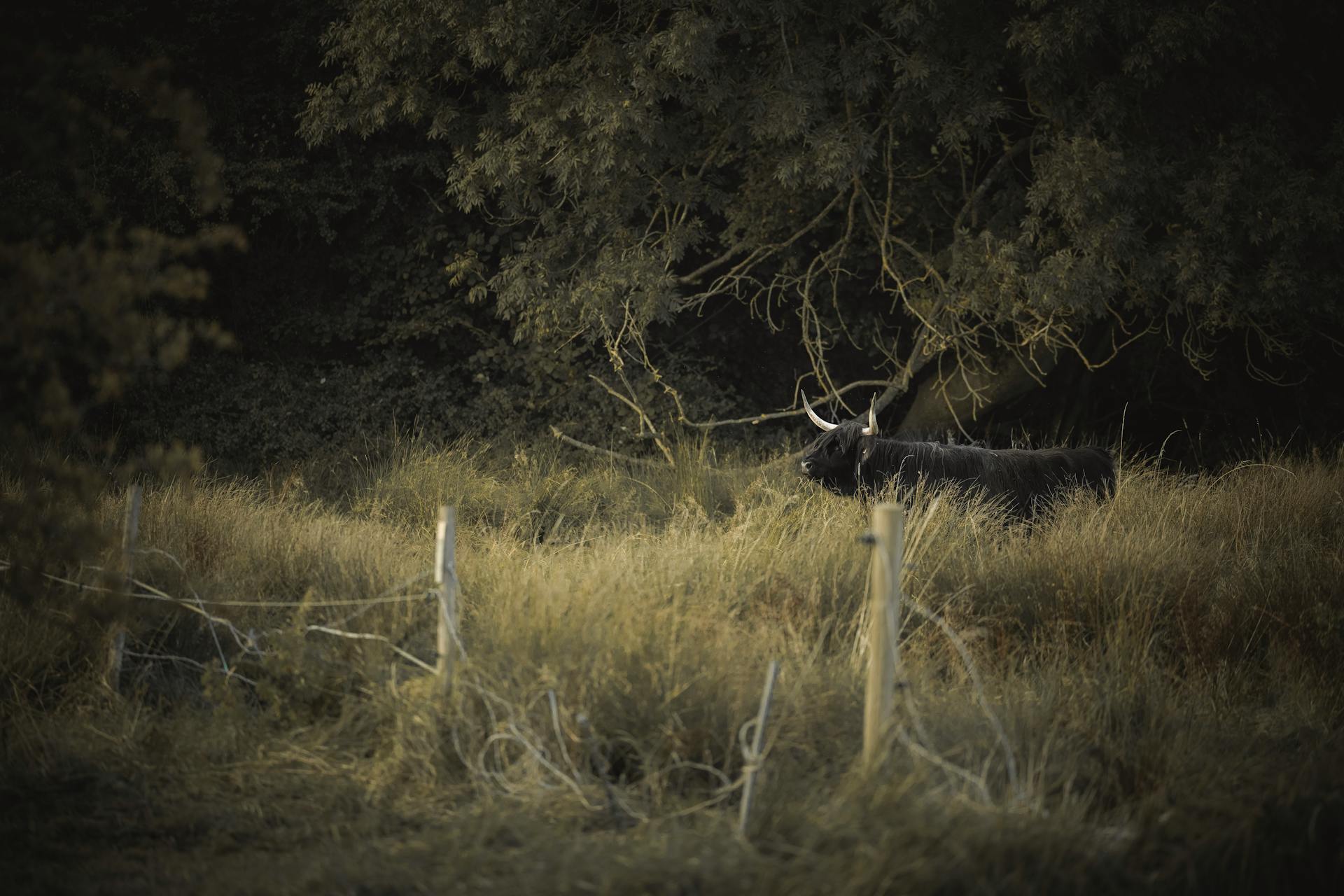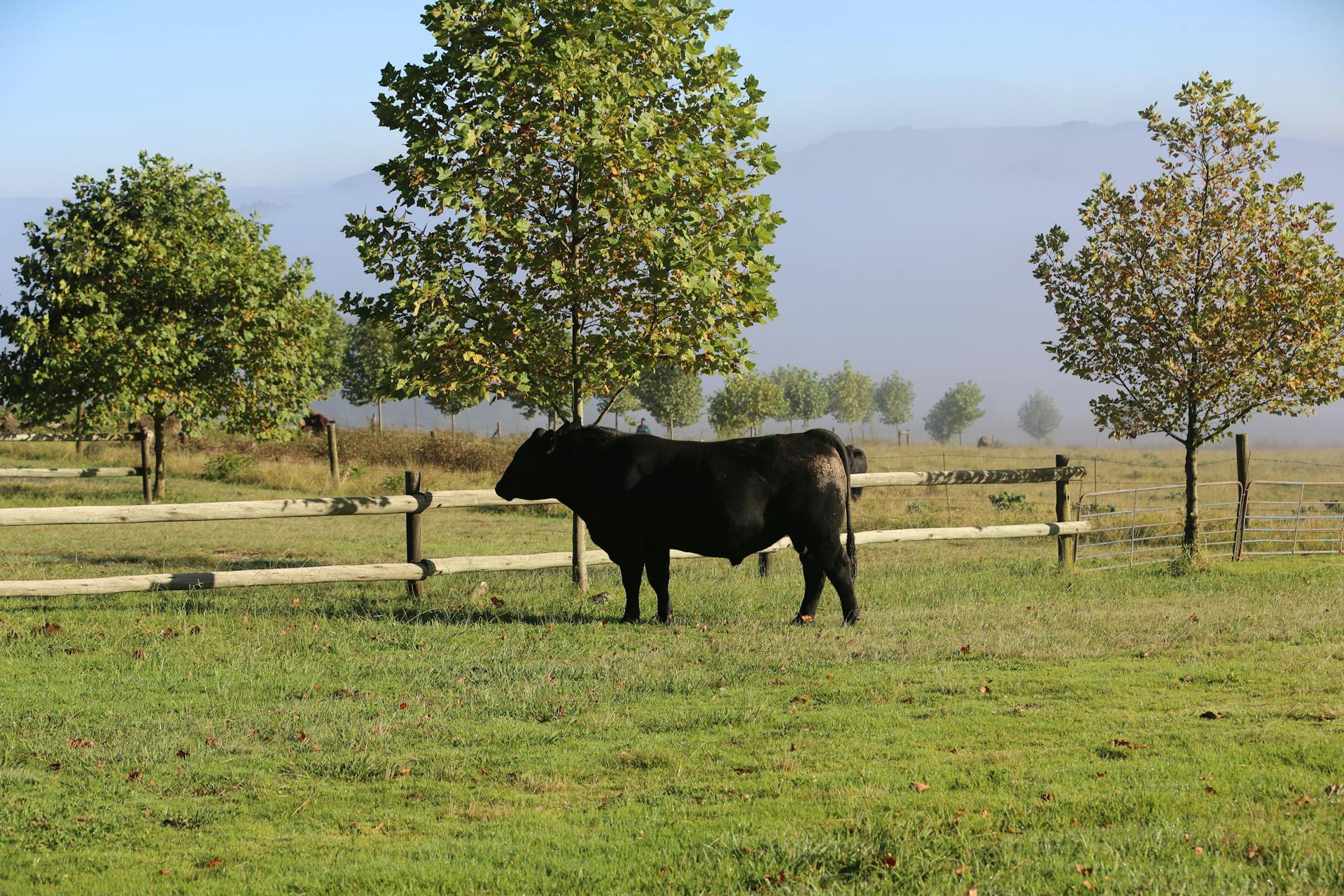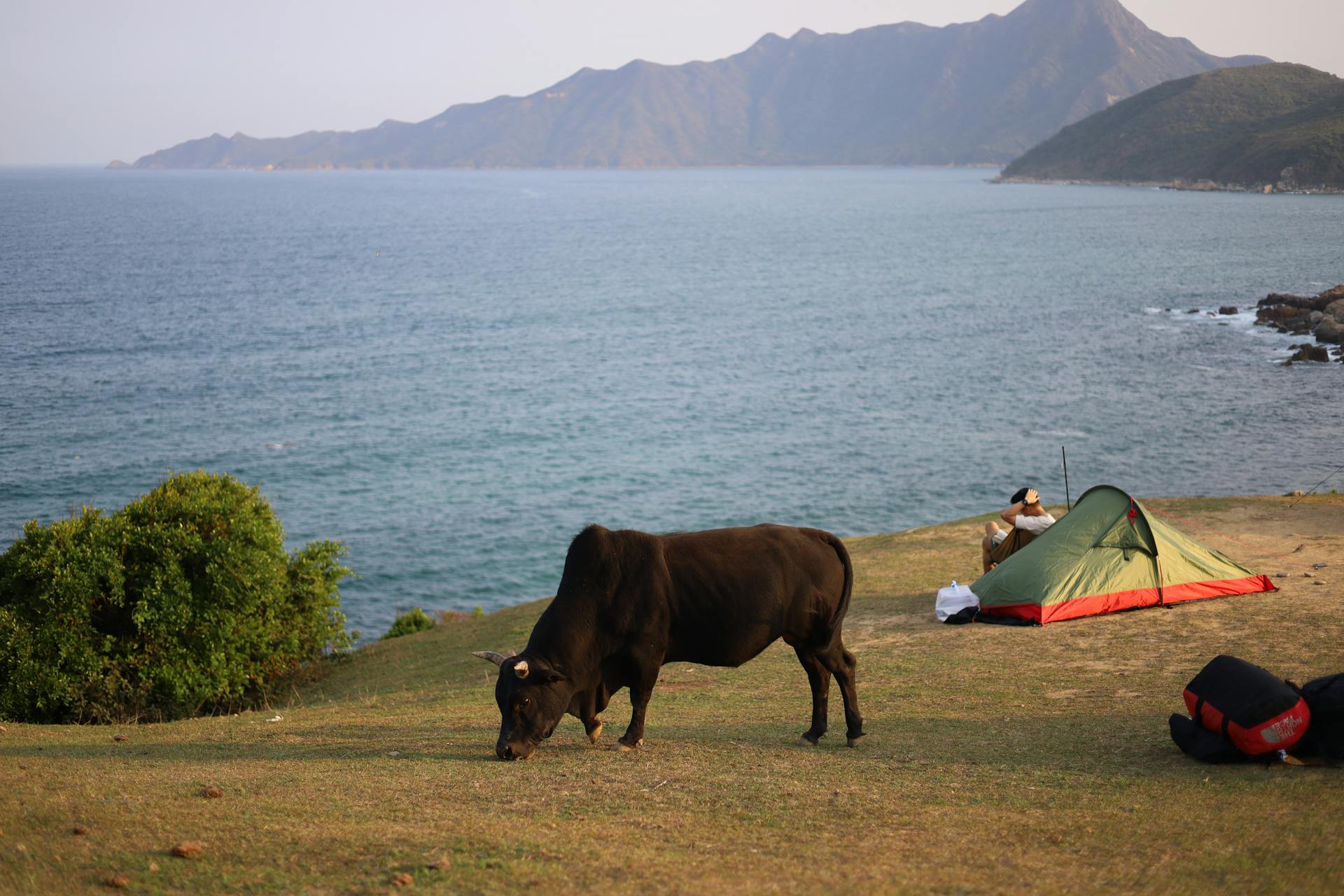
The Black Bull Terrier is a unique and fascinating breed. They are a variation of the Bull Terrier, known for their distinctive black coat.
These dogs are medium-sized, with males weighing between 50-70 pounds and standing about 20-24 inches tall.
Their short, easy-to-maintain coats require minimal grooming.
Physical Characteristics
The Black Bull Terrier's physical characteristics are truly unique. They have a strong, stocky, and muscular body that's slightly longer than it is tall.
Their head is shaped like a football, with a long and strong muzzle and a flat forehead that runs from ear to ear. This distinctive head shape is one of the breed's most recognizable features.
Their ears are small and thin, close together at the top of the head. The Bull Terrier's triangular eyes are small, dark, and deep-set, giving them a glinting, intelligent expression.
Their neck is long and strong, tapering from head to shoulders. The tail is short, set low, and carried horizontally.
The Black Bull Terrier's coat is short and flat, with a glossy sheen but a coarse texture to the touch. It comes in white and colors, but we're specifically focusing on the black variety.
Broaden your view: Pitbull Strong Dog
Health
Black bull terriers are generally a healthy breed, but like all breeds, they can be prone to certain health issues.
Kidney problems are a concern for black bull terriers, and it's essential to monitor their kidney function with regular blood tests.
Bull terriers are also susceptible to hearing problems, with the white-coated variety being especially prone to deafness.
In colored bull terriers, deafness is typically limited to one ear.
Here are some common health issues to watch out for in black bull terriers:
- Kidney problems
- Mild heart issues
- Patellar luxation (dislocated kneecap)
- Hearing problems
Breed Maintenance
The black Bull Terrier is a relatively low-maintenance breed when it comes to grooming. They only need to be brushed once or twice a week to remove loose hair.
Their short coat is not hypoallergenic, so regular brushing will help reduce shedding issues. Regular nail trimming and ear cleaning are also a must.
Giving your black Bull Terrier a rubdown during playtime can also help reduce shedding and keep their coat shining. However, they do need to be bathed when necessary.
Expand your knowledge: When to Mate Female Dog in Heat
Daily exercise is a must for this breed, as they love to play and can be quite active. They can be exercised indoors or outdoors, and they especially love going for walks.
But what's most important is that they receive attention and affection from their human family. They don't do well when left alone, so it's essential to spend quality time with them.
Their dietary needs are similar to any other mammal, but they do best on a balanced diet. This can be achieved with commercially made food or a homemade, fresh diet.
Temperament and Behavior
Bull Terriers can be both independent and stubborn, making them not suitable for inexperienced dog owners.
They have an even temperament and are amenable to discipline, which is a great quality for a family pet. Bull Terriers are generally sweet and good-natured, though they may be aggressive around other dogs.
These dogs are energetic and love to exercise, play, and walk long distances, making them perfect for active people. They are also very trainable when firm and positive encouragement are used.
Terrier Breed Group
The Terrier breed group is a hardy collection of dogs that were selectively bred to be extremely brave and tough.
These dogs were originally bred and used for hunting vermin, making them well-suited for pursuing small game above and below ground.
Their Latin name, Terrier, comes from the word Terra, meaning earth, reflecting their origins as ground-hunting dogs.
Dogs of terrier type have been known since ancient times, and were even portrayed by writers and painters as early as the Middle Ages.
Temperament
Bull Terriers have been described as stubborn and comical with imagination, making them a unique breed.
They are generally good-natured and do well with families, but families with small children need to monitor their activities closely as they can be rambunctious in play.
Bull Terriers are very trainable when firm and positive encouragement are used, making them a great choice for active people who are willing to invest time and effort into training.
They can be protective if they sense that a family member is in danger, but they are not considered a good protection breed.
Early socialization is crucial to ensure that the dog will get along with other dogs and animals, and to help them become a well-adjusted member of the family.
A 2008 study in Germany found that Bull Terriers did not have any significant temperament difference from Golden Retrievers in overall temperament researches.
Bull Terriers are energetic and love to exercise, play, and walk long distances, making them a great companion for active families.
They can be overly domineering with smaller animals who also live in the household, so it's essential to socialize them early and teach them to respect other pets.
The breed is particularly good with people, making them a great choice for families with older, more respectful children.
History and Inclusion
The Bull Terrier breed has a rich history that spans over a century. Developed in 19th-century England, the breed was created by crossing the Old English Bulldog with the Old English Terrier and possibly other terriers.
One of the key figures in the development of the Bull Terrier was James Hinks, who started breeding the breed with English White Terriers in the mid-19th century. He wanted to create a cleaner appearance with better legs and a nicer head.
The breed was initially developed for dogfighting, but it was never intended to be an aggressive fight provoker. Instead, it was bred to be a courageous fighter.
Here are some key characteristics of the Bull Terrier:
- Tall: 21 to 22 inches (53 to 56 cm)
- Weight: 50 to 70 pounds (23 to 32 kg)
- Coat: Short, may be coloured or white
- Ears: Erect
- Head: Egg-shaped, or convex
History
The Bull Terrier breed has a rich history that's worth exploring. At the start of the 19th century, the breed was developed to satisfy the needs for vermin control and animal-based blood sports.
The original breed was a combination of the Old English Bulldog and Old English Terriers, with possible other terriers. This mix of breeds aimed to create a dog that was both fast and tenacious. Many breeders at the time believed that crossing a bulldog with a terrier would enhance the fighting quality of the breed.

James Hinks is credited with starting to breed bull and terriers with English White Terriers in the mid-19th century. He wanted a cleaner appearance with better legs and a nicer head. Hinks entered a dog named "Puss" into the Bull Terrier Class at a dog show in London in 1862.
The breed quickly gained popularity, and breeding continued with the introduction of new breeds such as the Dalmatian, Spanish Pointer, and Whippet. These breeds helped increase the elegance and agility of the Bull Terrier. However, the breed's original stop in the skull profile remained until the early 20th century.
The first modern Bull Terrier, "Lord Gladiator", was born in 1917 and had no stop at all. Due to medical problems associated with all-white breeding, breeders began introducing color to the breed. The American Kennel Club (AKC) recognized colored Bull Terriers as a separate variety in 1936.
Here are some key dates in the history of the Bull Terrier breed:
- 1862: James Hinks enters "Puss" into the Bull Terrier Class at a dog show in London.
- 1917: "Lord Gladiator" is born, marking the first modern Bull Terrier with no stop.
- 1936: The AKC recognizes colored Bull Terriers as a separate variety.
Legislation Inclusion

Bull Terriers were developed in 19th-century England from the Bulldog, the White English Terrier, and the Dalmatian, among other breeds.
The Bull Terrier was initially bred for dogfighting pits as a courageous fighter, not as an aggressive fight provoker.
Bull Terriers are muscular dogs with a short coat, tapering tail, and erect ears, and they come in a variety of colors including brindle and white.
They stand 21 to 22 inches tall at the withers and weigh about 50 to 70 pounds, making them one of the strongest dogs of their weight.
In contrast, the miniature Bull Terrier stands 10 to 14 inches tall and weighs 24 to 33 pounds.
Bull Terriers are active, loyal, and playful, and are known for being even a bit clownish at times.
The breed's strength and agility make them a popular companion dog, despite their origins in dogfighting pits.
Frequently Asked Questions
Can Bull Terriers be black?
Yes, Bull Terriers can be black, one of the six recognized colors for the breed. They can also come in a variety of other colors, including white, red, fawn, brindle, and combinations of these.
Are Bull Terriers autistic?
Bull Terriers are not considered autistic, but they are a breed that is more vulnerable to autism-like behaviors in dogs. If you suspect your Bull Terrier may be exhibiting autistic traits, learn more about the risk factors and signs of autism in dogs.
What two dogs make a Bull Terrier?
A Bull Terrier is a cross between the old English terrier and the bulldog.
Featured Images: pexels.com


